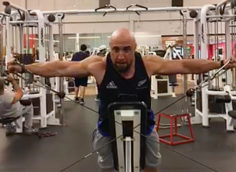While becoming stronger for sets of 5-8 reps on the basic pressing movements is the key to great delts, there's no doubt that properly executed lateral raises can help you get there faster.
How? Both by directly developing the delts and by improving your capacity to recruit them so they're better stimulated when you do heavy pressing work.
When used to develop a solid mind-muscle connection, lateral raises can be done pretty much every day. Here's why:
First, they cause very little muscle damage. Muscle damage is created when you're stretching the muscle fibers under load and tension. That occurs during the eccentric phase of the movement.
In lateral raises, only the top quarter of the range of motion is under significant loading. Let's say that in the finish position your arms form a 90-degree angle with your torso. Your delts are only under significant loading when the arms reach about 70-75 degrees. Before that you aren't moving opposite the source of resistance (which is directly down). You're moving more sideways than up.
It's the same thing when you're going down – the deltoid (especially the medial head) will be under load only for the first quarter of the eccentric range of motion, which is when the muscle is shortened. When the muscle is stretched, there's literally zero tension on the delts.
On top of that, if you do the lateral raise properly (no swinging at the bottom where there's no resistance and you can easily speed up), you won't be using a lot of weight, which also decreases the amount of muscle damage.
Since the movement isn't neurologically demanding, it likely won't hurt neurological recovery either.
How to Make the Most of Lateral Raises
- Initiate the movement by trying to push away, not lift up. This will put more focus on the medial head of the delt and less on traps. Getting tension in the traps instead of the shoulders causes frustration for a lot of lifters. If you're one of them, see my tip on this. This also works with the incline variation:
- Use zero momentum in the first half of the movement. From the bottom to a bit higher than the mid-range, the resistance is very low. You could easily do half of the lateral raise with 60-pound dumbbells even if you can only use 20 pounds for the full range.
- Since there's very little resistance, creating acceleration in the bottom is super easy. The problem is, if you create enough momentum, it'll take away from the muscle contraction work that occurs in the final portion of the range of motion. So do the first half of the movement under control; focus hard on not accelerating.
- At the top of the range of motion, hold for two seconds per rep. This is helpful for two reasons. First, the active range of motion is short; the delts only contract maximally for the last 15-20 degrees. That's not a lot of time under tension to create muscle fiber fatigue and force adaptation. By holding at the top, you increase muscle fiber fatigue. And second, the hold helps develop mind-muscle connection.
- While holding the top position, also try to push out. This will switch even more of the stress on the medial head of the delt, which is the part that we really want to develop.
- Shoot for a set duration of at least 40 seconds. Since we aren't causing muscle damage, we must rely on muscle fiber fatigue as well as lactate and growth factor accumulation to stimulate growth. This requires a bit more time under tension. With the two-second hold at the top, that comes down to around 12 reps per set.
You can easily do 3-4 sets of 12 in this fashion every day to improve mind-muscle connection and stimulate growth.




